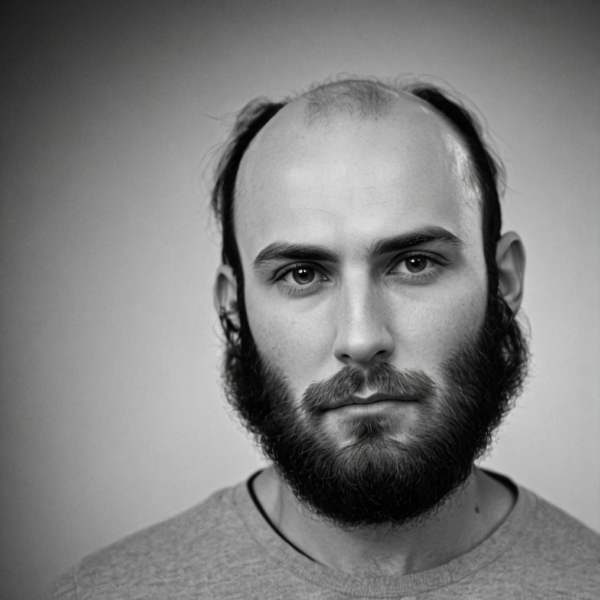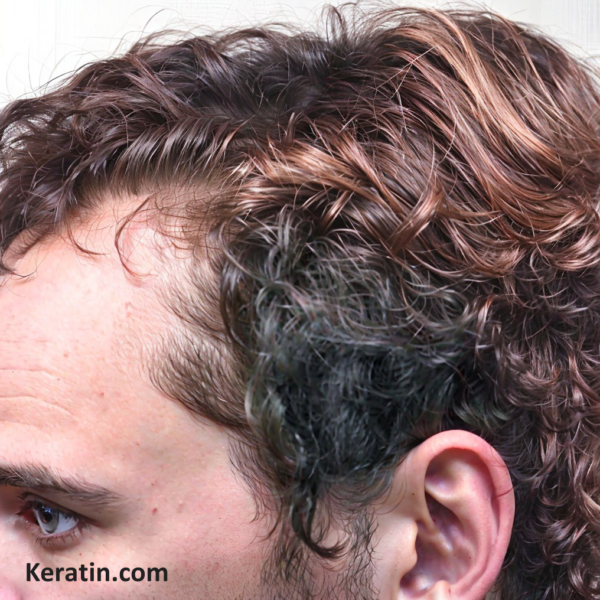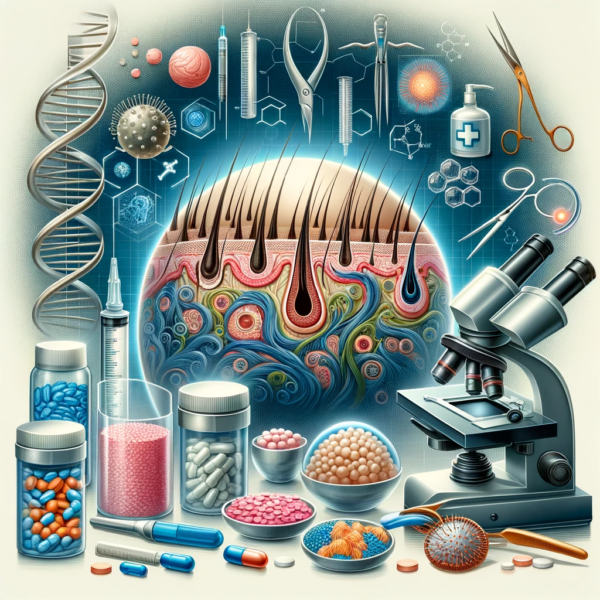Androgens, a group of hormones that includes testosterone and dihydrotestosterone (DHT), play a significant role in the development of secondary characteristics in both men and women, including hair growth. However, the paradoxical effect of androgens on hair growth, where they promote hair growth in certain areas like the beard and arm pit (axillary) regions, while causing hair loss or baldness in the scalp, has been the subject of extensive research. This article aims to delve into the potential mechanisms underlying this androgenic paradox.
Androgenetic alopecia, commonly known as male pattern baldness, is a condition characterized by hair loss from the scalp’s vertex and frontal areas. It is primarily driven by the effects of DHT, a particularly potent androgen, on hair follicles. Hair follicles in these regions are genetically predisposed to be sensitive to DHT.
DHT binds to androgen receptors, mostly found on dermal papilla cells, triggering a cascade of events that lead to the miniaturization of the hair follicles. This process involves the shortening of the anagen (growth) phase and the elongation of the telogen (resting) phase of the hair cycle, resulting in the production of shorter hair. As time goes on, cells start to die off and disappear from the affected follicles, this first leads to thinner hairs, then follicular miniaturization and eventually to hair loss.
In contrast, in the beard area, androgens, including the same DHT, promote hair growth. The hair follicles in the beard area are different from those on the scalp in their response to DHT. Instead of miniaturizing the follicles, DHT stimulates them, leading to thicker, coarser hair growth.
In one study, cells were cultured in petri dishes and exposed to androgens. When dermal papilla cells from a balding scalp were stimulated by androgens, it resulted in the inhibition of keratinocyte growth. This inhibition was facilitated by transforming growth factor-beta1 (TGF-beta1), which is produced by dermal papilla cells in men with androgenetic alopecia. However, when beard dermal papilla cells were stimulated by androgens there was a rise in the expression of insulin-like growth factor 1 (IGF-1), which in turn promoted the growth of keratinocytes.
The exact mechanism behind this differential response is not fully understood. However, it is believed to be related to variations in androgen receptor distribution, the presence of different cofactors, and the differential expression of genes in the hair follicles of the scalp and beard area. For example, studies looking for 5 alpha reductase mRNA expression revealed stronger expression in dermal papilla cells from occipital scalp hair follicles than from beard follicles. 5 alpha reductase is an enzyme that converts testosterone to DHT, so less 5 alpha reductase probably means beard follicles convert less testosterone to DHT.
Androgen receptors are proteins on the surface of cells that bind to androgens, allowing them to exert their effects. The distribution and density of these receptors vary between different body sites. For instance, cells in hair follicles in the beard area have been found to have a much higher density of androgen receptors compared to those on the scalp, which could help explain their increased responsiveness to androgens.
Additionally, the action of androgens is modulated by various cofactors, proteins that enhance or inhibit the activity of androgens. There may also be a complex interplay between signaling by testosterone, which can also bind to androgen receptors, and signaling from DHT. The differential expression of these cofactors in different body sites could contribute to the androgenic paradox.
Genetic factors also play a crucial role in determining the response of hair follicles to androgens. Studies have found that certain genes are differentially expressed in the hair follicles of the scalp and beard area. These genes could influence the sensitivity of hair follicles to DHT, thereby contributing to the differential effects of androgens on hair growth in these areas.
In conclusion, the androgenic paradox, where the same hormone promotes hair growth in one area and causes hair loss in another, is a complex phenomenon that is likely to be influenced by a combination of factors, including the distribution of androgen receptors, the presence of cofactors, and genetic factors. Further research is needed to fully understand these mechanisms, which could potentially lead to new therapeutic approaches for conditions like androgenic alopecia.
Bibliography
11711645 {11711645:JJN9KXW2},{11711645:HF9P8FXK},{11711645:3UQ8V8J4},{11711645:VCWVABXU},{11711645:3B6PW5XM},{11711645:RUKQB9NC},{11711645:GAX3F2JH},{11711645:G5HPBF7N},{11711645:SA5XGKTA} vancouver 50 date asc 142 https://www.keratin.com/wp-content/plugins/zotpress/ %7B%22status%22%3A%22success%22%2C%22updateneeded%22%3Afalse%2C%22instance%22%3A%22zotpress-ba3919b689f1653c6f34261d6dda60de%22%2C%22meta%22%3A%7B%22request_last%22%3A0%2C%22request_next%22%3A0%2C%22used_cache%22%3Atrue%7D%2C%22data%22%3A%5B%7B%22key%22%3A%22HF9P8FXK%22%2C%22library%22%3A%7B%22id%22%3A11711645%7D%2C%22meta%22%3A%7B%22creatorSummary%22%3A%22Itami%20et%20al.%22%2C%22parsedDate%22%3A%221991-01%22%2C%22numChildren%22%3A0%7D%2C%22bib%22%3A%22%3Cdiv%20class%3D%5C%22csl-bib-body%5C%22%20style%3D%5C%22line-height%3A%201.35%3B%20%5C%22%3E%5Cn%20%20%3Cdiv%20class%3D%5C%22csl-entry%5C%22%20style%3D%5C%22clear%3A%20left%3B%20%5C%22%3E%5Cn%20%20%20%20%3Cdiv%20class%3D%5C%22csl-left-margin%5C%22%20style%3D%5C%22float%3A%20left%3B%20padding-right%3A%200.5em%3B%20text-align%3A%20right%3B%20width%3A%201em%3B%5C%22%3E1.%3C%5C%2Fdiv%3E%3Cdiv%20class%3D%5C%22csl-right-inline%5C%22%20style%3D%5C%22margin%3A%200%20.4em%200%201.5em%3B%5C%22%3EItami%20S%2C%20Kurata%20S%2C%20Sonoda%20T%2C%20Takayasu%20S.%20Characterization%20of%205%20alpha-reductase%20in%20cultured%20human%20dermal%20papilla%20cells%20from%20beard%20and%20occipital%20scalp%20hair.%20J%20Invest%20Dermatol.%201991%20Jan%3B96%281%29%3A57%26%23x2013%3B60.%3C%5C%2Fdiv%3E%5Cn%20%20%20%3C%5C%2Fdiv%3E%5Cn%3C%5C%2Fdiv%3E%22%2C%22data%22%3A%7B%22itemType%22%3A%22journalArticle%22%2C%22title%22%3A%22Characterization%20of%205%20alpha-reductase%20in%20cultured%20human%20dermal%20papilla%20cells%20from%20beard%20and%20occipital%20scalp%20hair%22%2C%22creators%22%3A%5B%7B%22creatorType%22%3A%22author%22%2C%22firstName%22%3A%22S.%22%2C%22lastName%22%3A%22Itami%22%7D%2C%7B%22creatorType%22%3A%22author%22%2C%22firstName%22%3A%22S.%22%2C%22lastName%22%3A%22Kurata%22%7D%2C%7B%22creatorType%22%3A%22author%22%2C%22firstName%22%3A%22T.%22%2C%22lastName%22%3A%22Sonoda%22%7D%2C%7B%22creatorType%22%3A%22author%22%2C%22firstName%22%3A%22S.%22%2C%22lastName%22%3A%22Takayasu%22%7D%5D%2C%22abstractNote%22%3A%22In%20order%20to%20gain%20a%20deeper%20insight%20into%20the%20role%20of%205%20alpha-reductase%20in%20the%20growth%20of%20beards%20in%20men%2C%20we%20studied%20some%20kinetic%20properties%20of%20the%20enzyme%20in%20cell%20homogenates%20of%20cultured%20human%20dermal%20papilla%20cells%20from%20beard%20and%20occipital%20scalp%20hair.%20When%20cell%20homogenates%20were%20incubated%20with%20%5B3H%5D-testosterone%2C%20the%205%20alpha-reductase%20of%20beard%20dermal%20papilla%20cells%20exhibited%20an%20optimum%20activity%20at%20pH%205.5%2C%20whereas%20the%20enzyme%20of%20dermal%20papilla%20cells%20from%20occipital%20scalp%20hair%20showed%20a%20broad%20and%20low%20plateau%20between%20pH%206.0%20and%209.0%2C%20without%20a%20sharp%20peak.%20The%20apparent%20Michaelis%20constant%20of%205%20alpha-reductase%20was%203.3%20x%2010%28-7%29%20M%20in%20dermal%20papilla%20cells%20from%20beard%20and%202.4%20x%2010%28-5%29%20M%20in%20those%20cells%20from%20occipital%20scalp%20hair.%20The%20apparent%20Km%20of%205%20alpha-reductase%20for%20NADPH%20was%202.8%20x%2010%28-5%29%20M%20and%207.6%20x%2010%28-4%29%20M%20in%20beard%20and%20occipital%20scalp%20hair%20dermal%20papilla%20cells%2C%20respectively.%20There%20were%20no%20significant%20differences%20in%20the%20substrate%20specificity%20between%20these%20two%20types%20of%20cells.%20The%205%20alpha-reductase%20activity%20was%20recovered%20mainly%20in%20the%20nuclear%20fraction%20of%20beard%20dermal%20papilla%20cells.%20By%20contrast%2C%20it%20was%20widely%20distributed%20among%20the%20individual%20subcellular%20fractions%20of%20dermal%20papilla%20cells%20from%20occipital%20scalp%20hair.%20These%20results%20strongly%20suggest%20that%20these%20two%20kinds%20of%20dermal%20papilla%20cells%20have%20different%20types%20of%205%20alpha-reductase%2C%20and%20that%20the%20enzyme%20in%20beard%20dermal%20papilla%20cells%20is%20similar%20in%20characteristics%20to%20that%20in%20the%20androgen%20target%20organs%20such%20as%20prostate.%22%2C%22date%22%3A%221991-01%22%2C%22language%22%3A%22eng%22%2C%22DOI%22%3A%2210.1111%5C%2F1523-1747.ep12514729%22%2C%22ISSN%22%3A%220022-202X%22%2C%22url%22%3A%22%22%2C%22collections%22%3A%5B%224VP2744G%22%5D%2C%22dateModified%22%3A%222023-05-20T20%3A37%3A23Z%22%7D%7D%2C%7B%22key%22%3A%223B6PW5XM%22%2C%22library%22%3A%7B%22id%22%3A11711645%7D%2C%22meta%22%3A%7B%22creatorSummary%22%3A%22Randall%20et%20al.%22%2C%22parsedDate%22%3A%221992-04%22%2C%22numChildren%22%3A0%7D%2C%22bib%22%3A%22%3Cdiv%20class%3D%5C%22csl-bib-body%5C%22%20style%3D%5C%22line-height%3A%201.35%3B%20%5C%22%3E%5Cn%20%20%3Cdiv%20class%3D%5C%22csl-entry%5C%22%20style%3D%5C%22clear%3A%20left%3B%20%5C%22%3E%5Cn%20%20%20%20%3Cdiv%20class%3D%5C%22csl-left-margin%5C%22%20style%3D%5C%22float%3A%20left%3B%20padding-right%3A%200.5em%3B%20text-align%3A%20right%3B%20width%3A%201em%3B%5C%22%3E1.%3C%5C%2Fdiv%3E%3Cdiv%20class%3D%5C%22csl-right-inline%5C%22%20style%3D%5C%22margin%3A%200%20.4em%200%201.5em%3B%5C%22%3ERandall%20VA%2C%20Thornton%20MJ%2C%20Messenger%20AG.%20Cultured%20dermal%20papilla%20cells%20from%20androgen-dependent%20human%20hair%20follicles%20%28e.g.%20beard%29%20contain%20more%20androgen%20receptors%20than%20those%20from%20non-balding%20areas%20of%20scalp.%20J%20Endocrinol.%201992%20Apr%3B133%281%29%3A141%26%23x2013%3B7.%3C%5C%2Fdiv%3E%5Cn%20%20%20%3C%5C%2Fdiv%3E%5Cn%3C%5C%2Fdiv%3E%22%2C%22data%22%3A%7B%22itemType%22%3A%22journalArticle%22%2C%22title%22%3A%22Cultured%20dermal%20papilla%20cells%20from%20androgen-dependent%20human%20hair%20follicles%20%28e.g.%20beard%29%20contain%20more%20androgen%20receptors%20than%20those%20from%20non-balding%20areas%20of%20scalp%22%2C%22creators%22%3A%5B%7B%22creatorType%22%3A%22author%22%2C%22firstName%22%3A%22V.%20A.%22%2C%22lastName%22%3A%22Randall%22%7D%2C%7B%22creatorType%22%3A%22author%22%2C%22firstName%22%3A%22M.%20J.%22%2C%22lastName%22%3A%22Thornton%22%7D%2C%7B%22creatorType%22%3A%22author%22%2C%22firstName%22%3A%22A.%20G.%22%2C%22lastName%22%3A%22Messenger%22%7D%5D%2C%22abstractNote%22%3A%22Androgens%20stimulate%20hair%20growth%20in%20many%20areas%2C%20e.g.%20the%20beard%3B%20they%20also%20induce%20regression%20and%20balding%20on%20the%20scalp%20with%20increasing%20age%20in%20genetically%20disposed%20individuals.%20The%20cause%28s%29%20of%20this%20biological%20conundrum%20is%20unknown%20but%20age-related%3B%20androgen-potentiated%20changes%20also%20occur%20in%20the%20prostate.%20The%20mesenchyme-derived%20dermal%20papilla%20situated%20at%20the%20base%20of%20the%20hair%20follicle%20is%20thought%20to%20play%20an%20important%20role%20in%20regulating%20the%20growth%20and%20development%20of%20the%20follicular%20epithelium.%20Since%20androgens%20probably%20act%20on%20the%20hair%20follicle%20via%20the%20dermal%20papilla%2C%20cultures%20of%20dermal%20papilla%20cells%20from%20human%20hair%20follicles%20with%20differing%20responses%20to%20androgens%20in%20vivo%20have%20been%20established%20and%20their%20ability%20to%20bind%20androgens%20assessed.%20Receptor%20binding%20was%20assayed%20by%20saturation%20analysis%20%280.05-10%20nmol%5C%2Fl%29%20using%20the%20synthetic%20non-metabolizable%20androgen%2C%20%5B3H%5Dmibolerone.%20Shionogi%20115%20cells%20were%20also%20assayed%20as%20a%20positive%20control.%20Specific%20high-affinity%20low-capacity%20androgen%20receptors%20were%20identified%20in%2012%20dermal%20papilla%20primary%20cell%20lines%20with%20similar%20characteristics%20to%20established%20androgen%20receptors.%20Cells%20from%20androgen-sensitive%20follicles%20%28beard%2C%20scrotum%20and%20pubis%29%20contained%20higher%20levels%20of%20androgen%20receptors%20than%20those%20derived%20from%20relatively%20androgen-insensitive%20non-balding%20scalp%20follicles%20whether%20the%20receptor%20content%20was%20calculated%20in%20relation%20to%20cell%20number%2C%20protein%20or%20DNA%20content%20of%20the%20cells.%20These%20results%20support%20the%20hypothesis%20that%20androgens%20act%20on%20hair%20follicles%20via%20the%20dermal%20papilla%20in%20vivo%20and%20demonstrate%20that%20dermal%20papilla%20cells%20exhibit%20an%20altered%20phenotype%20in%20culture%20which%20depends%20on%20the%20body%20site%20from%20which%20they%20were%20derived.%28ABSTRACT%20TRUNCATED%20AT%20250%20WORDS%29%22%2C%22date%22%3A%221992-04%22%2C%22language%22%3A%22eng%22%2C%22DOI%22%3A%2210.1677%5C%2Fjoe.0.1330141%22%2C%22ISSN%22%3A%220022-0795%22%2C%22url%22%3A%22%22%2C%22collections%22%3A%5B%224VP2744G%22%5D%2C%22dateModified%22%3A%222023-05-20T20%3A41%3A18Z%22%7D%7D%2C%7B%22key%22%3A%223UQ8V8J4%22%2C%22library%22%3A%7B%22id%22%3A11711645%7D%2C%22meta%22%3A%7B%22creatorSummary%22%3A%22Itami%20et%20al.%22%2C%22parsedDate%22%3A%221995-07-26%22%2C%22numChildren%22%3A0%7D%2C%22bib%22%3A%22%3Cdiv%20class%3D%5C%22csl-bib-body%5C%22%20style%3D%5C%22line-height%3A%201.35%3B%20%5C%22%3E%5Cn%20%20%3Cdiv%20class%3D%5C%22csl-entry%5C%22%20style%3D%5C%22clear%3A%20left%3B%20%5C%22%3E%5Cn%20%20%20%20%3Cdiv%20class%3D%5C%22csl-left-margin%5C%22%20style%3D%5C%22float%3A%20left%3B%20padding-right%3A%200.5em%3B%20text-align%3A%20right%3B%20width%3A%201em%3B%5C%22%3E1.%3C%5C%2Fdiv%3E%3Cdiv%20class%3D%5C%22csl-right-inline%5C%22%20style%3D%5C%22margin%3A%200%20.4em%200%201.5em%3B%5C%22%3EItami%20S%2C%20Kurata%20S%2C%20Takayasu%20S.%20Androgen%20induction%20of%20follicular%20epithelial%20cell%20growth%20is%20mediated%20via%20insulin-like%20growth%20factor-I%20from%20dermal%20papilla%20cells.%20Biochem%20Biophys%20Res%20Commun.%201995%20Jul%2026%3B212%283%29%3A988%26%23x2013%3B94.%3C%5C%2Fdiv%3E%5Cn%20%20%20%3C%5C%2Fdiv%3E%5Cn%3C%5C%2Fdiv%3E%22%2C%22data%22%3A%7B%22itemType%22%3A%22journalArticle%22%2C%22title%22%3A%22Androgen%20induction%20of%20follicular%20epithelial%20cell%20growth%20is%20mediated%20via%20insulin-like%20growth%20factor-I%20from%20dermal%20papilla%20cells%22%2C%22creators%22%3A%5B%7B%22creatorType%22%3A%22author%22%2C%22firstName%22%3A%22S.%22%2C%22lastName%22%3A%22Itami%22%7D%2C%7B%22creatorType%22%3A%22author%22%2C%22firstName%22%3A%22S.%22%2C%22lastName%22%3A%22Kurata%22%7D%2C%7B%22creatorType%22%3A%22author%22%2C%22firstName%22%3A%22S.%22%2C%22lastName%22%3A%22Takayasu%22%7D%5D%2C%22abstractNote%22%3A%22Androgen%20significantly%20stimulates%20the%20proliferation%20of%20outer%20root%20sheath%20cells%20that%20are%20cocultured%20with%20beard%20dermal%20papilla%20cells%20without%20cell%20contact.%20The%20expression%20of%20insulin-like%20growth%20factor%20I%20%28IGF-I%29%20mRNA%20in%20beard%20dermal%20papilla%20cells%20was%20stimulated%20by%20androgen%20and%20antagonized%20by%20cyproterone%20acetate.%20Outer%20root%20sheath%20cells%20did%20not%20express%20mRNA%20for%20IGF-I%20either%20in%20the%20presence%20or%20absence%20of%20androgen.%20Both%20of%20these%20two%20types%20of%20cells%20expressed%20mRNA%20for%20IGF-I%20receptor%20and%20the%20expression%20was%20not%20affected%20by%20androgen.%20Neutralizing%20antibody%20against%20IGF-I%20antagonized%20the%20stimulatory%20effect%20of%20androgen%20on%20the%20growth%20of%20outer%20root%20sheath%20cell%20cocultured%20with%20beard%20dermal%20papilla%20cells.%20These%20findings%20suggest%20that%20IGF-I%20is%20a%20candidate%20for%20androgen%20induced%20hair%20growth%20factors.%22%2C%22date%22%3A%221995-07-26%22%2C%22language%22%3A%22eng%22%2C%22DOI%22%3A%2210.1006%5C%2Fbbrc.1995.2067%22%2C%22ISSN%22%3A%220006-291X%22%2C%22url%22%3A%22%22%2C%22collections%22%3A%5B%224VP2744G%22%5D%2C%22dateModified%22%3A%222023-05-20T20%3A39%3A24Z%22%7D%7D%2C%7B%22key%22%3A%22SA5XGKTA%22%2C%22library%22%3A%7B%22id%22%3A11711645%7D%2C%22meta%22%3A%7B%22creatorSummary%22%3A%22Hibberts%20et%20al.%22%2C%22parsedDate%22%3A%221996-05-15%22%2C%22numChildren%22%3A0%7D%2C%22bib%22%3A%22%3Cdiv%20class%3D%5C%22csl-bib-body%5C%22%20style%3D%5C%22line-height%3A%201.35%3B%20%5C%22%3E%5Cn%20%20%3Cdiv%20class%3D%5C%22csl-entry%5C%22%20style%3D%5C%22clear%3A%20left%3B%20%5C%22%3E%5Cn%20%20%20%20%3Cdiv%20class%3D%5C%22csl-left-margin%5C%22%20style%3D%5C%22float%3A%20left%3B%20padding-right%3A%200.5em%3B%20text-align%3A%20right%3B%20width%3A%201em%3B%5C%22%3E1.%3C%5C%2Fdiv%3E%3Cdiv%20class%3D%5C%22csl-right-inline%5C%22%20style%3D%5C%22margin%3A%200%20.4em%200%201.5em%3B%5C%22%3EHibberts%20NA%2C%20Messenger%20AG%2C%20Randall%20VA.%20Dermal%20papilla%20cells%20derived%20from%20beard%20hair%20follicles%20secrete%20more%20stem%20cell%20factor%20%28SCF%29%20in%20culture%20than%20scalp%20cells%20or%20dermal%20fibroblasts.%20Biochem%20Biophys%20Res%20Commun.%201996%20May%2015%3B222%282%29%3A401%26%23x2013%3B5.%3C%5C%2Fdiv%3E%5Cn%20%20%20%3C%5C%2Fdiv%3E%5Cn%3C%5C%2Fdiv%3E%22%2C%22data%22%3A%7B%22itemType%22%3A%22journalArticle%22%2C%22title%22%3A%22Dermal%20papilla%20cells%20derived%20from%20beard%20hair%20follicles%20secrete%20more%20stem%20cell%20factor%20%28SCF%29%20in%20culture%20than%20scalp%20cells%20or%20dermal%20fibroblasts%22%2C%22creators%22%3A%5B%7B%22creatorType%22%3A%22author%22%2C%22firstName%22%3A%22N.%20A.%22%2C%22lastName%22%3A%22Hibberts%22%7D%2C%7B%22creatorType%22%3A%22author%22%2C%22firstName%22%3A%22A.%20G.%22%2C%22lastName%22%3A%22Messenger%22%7D%2C%7B%22creatorType%22%3A%22author%22%2C%22firstName%22%3A%22V.%20A.%22%2C%22lastName%22%3A%22Randall%22%7D%5D%2C%22abstractNote%22%3A%22As%20stem%20cell%20factor%20%28SCF%29%20and%20its%20receptor%2C%20c-kit%2C%20are%20involved%20in%20hair%20pigmentation%2C%20SCF%20is%20probably%20produced%20in%20the%20skin%2C%20possibly%20by%20the%20regulatory%20follicular%20dermal%20papilla.%20Since%20androgens%20often%20alter%20the%20type%20and%20color%20of%20hair%2C%20probably%20via%20the%20dermal%20papilla%2C%20they%20may%20regulate%20its%20SCF%20production.%20SCF%20produced%20by%20beard%20and%20non-balding%20scalp%20dermal%20papilla%20cells%20in%20the%20presence%2C%20or%20absence%2C%20of%2010nM%20testosterone%20was%20assayed%20by%20ELISA.%20After%2024%20h%2C%20beard%20cells%20produced%20significantly%20%28p%20%3D%200.001%29%20more%20SCF%20than%20scalp%20cells%2C%20while%20beard%20and%20scalp%20fibroblasts%20secreted%20significantly%20%28p%20%3D%200.04%29%20less%20SCF.%20Testosterone%20in%20vitro%20had%20no%20effect%20on%20SCF%20secretion.%20These%20results%20support%20the%20hypotheses%20that%20the%20dermal%20papilla%20is%20a%20local%20source%20of%20SCF%20in%20hair%20follicles%20and%20that%20androgens%20would%20alter%20SCF%20production%20only%20at%20specific%20points%20of%20the%20hair%20cycle.%22%2C%22date%22%3A%221996-05-15%22%2C%22language%22%3A%22eng%22%2C%22DOI%22%3A%2210.1006%5C%2Fbbrc.1996.0756%22%2C%22ISSN%22%3A%220006-291X%22%2C%22url%22%3A%22%22%2C%22collections%22%3A%5B%224VP2744G%22%5D%2C%22dateModified%22%3A%222023-05-20T20%3A43%3A29Z%22%7D%7D%2C%7B%22key%22%3A%22VCWVABXU%22%2C%22library%22%3A%7B%22id%22%3A11711645%7D%2C%22meta%22%3A%7B%22creatorSummary%22%3A%22Thornton%20et%20al.%22%2C%22parsedDate%22%3A%221998-11%22%2C%22numChildren%22%3A0%7D%2C%22bib%22%3A%22%3Cdiv%20class%3D%5C%22csl-bib-body%5C%22%20style%3D%5C%22line-height%3A%201.35%3B%20%5C%22%3E%5Cn%20%20%3Cdiv%20class%3D%5C%22csl-entry%5C%22%20style%3D%5C%22clear%3A%20left%3B%20%5C%22%3E%5Cn%20%20%20%20%3Cdiv%20class%3D%5C%22csl-left-margin%5C%22%20style%3D%5C%22float%3A%20left%3B%20padding-right%3A%200.5em%3B%20text-align%3A%20right%3B%20width%3A%201em%3B%5C%22%3E1.%3C%5C%2Fdiv%3E%3Cdiv%20class%3D%5C%22csl-right-inline%5C%22%20style%3D%5C%22margin%3A%200%20.4em%200%201.5em%3B%5C%22%3EThornton%20MJ%2C%20Hamada%20K%2C%20Messenger%20AG%2C%20Randall%20VA.%20Androgen-dependent%20beard%20dermal%20papilla%20cells%20secrete%20autocrine%20growth%20factor%28s%29%20in%20response%20to%20testosterone%20unlike%20scalp%20cells.%20J%20Invest%20Dermatol.%201998%20Nov%3B111%285%29%3A727%26%23x2013%3B32.%3C%5C%2Fdiv%3E%5Cn%20%20%20%3C%5C%2Fdiv%3E%5Cn%3C%5C%2Fdiv%3E%22%2C%22data%22%3A%7B%22itemType%22%3A%22journalArticle%22%2C%22title%22%3A%22Androgen-dependent%20beard%20dermal%20papilla%20cells%20secrete%20autocrine%20growth%20factor%28s%29%20in%20response%20to%20testosterone%20unlike%20scalp%20cells%22%2C%22creators%22%3A%5B%7B%22creatorType%22%3A%22author%22%2C%22firstName%22%3A%22M.%20J.%22%2C%22lastName%22%3A%22Thornton%22%7D%2C%7B%22creatorType%22%3A%22author%22%2C%22firstName%22%3A%22K.%22%2C%22lastName%22%3A%22Hamada%22%7D%2C%7B%22creatorType%22%3A%22author%22%2C%22firstName%22%3A%22A.%20G.%22%2C%22lastName%22%3A%22Messenger%22%7D%2C%7B%22creatorType%22%3A%22author%22%2C%22firstName%22%3A%22V.%20A.%22%2C%22lastName%22%3A%22Randall%22%7D%5D%2C%22abstractNote%22%3A%22Androgens%20stimulate%20many%20hair%20follicles%2C%20e.g.%2C%20beard%2C%20but%20may%20cause%20regression%20on%20the%20scalp%3B%20occipital%20areas%20are%20considered%20androgen%20independent.%20The%20mesenchyme-derived%20dermal%20papilla%20that%20regulates%20the%20hair%20follicle%20is%20considered%20the%20site%20of%20androgen%20action.%20Because%20hair%20size%20has%20been%20clearly%20related%20to%20dermal%20papilla%20size%2C%20one%20of%20the%20key%20functions%20androgens%20must%20regulate%20is%20the%20size%20of%20the%20dermal%20papilla.%20This%20implies%20that%20androgens%20stimulate%20dermal%20papilla%20cells%20to%20divide%20or%20to%20secrete%20autocrine%20mitogenic%20factors.%20As%20physiologic%20levels%20of%20androgens%20do%20not%20stimulate%20mitogenesis%20in%20cultured%20dermal%20papilla%20cells%2C%20this%20study%20was%20designed%20to%20determine%20whether%20dermal%20papilla%20cells%20cultured%20from%20human%20hair%20follicles%20with%20different%20responses%20to%20androgens%20in%20vivo%2C%20i.e.%2C%20androgen-dependent%20beard%20and%20androgen-independent%20nonbalding%20scalp%2C%20produce%20soluble%20autocrine%20mitogenic%20factors%20and%2C%20if%20so%2C%20whether%20either%20cell%20type%20altered%20their%20secretion%20in%20response%20to%20testosterone%20in%20vitro.%20Conditioned%20medium%20was%20prepared%20by%20incubating%20individual%20primary%20lines%20of%20cells%20for%2024%20h%20with%2C%20and%20without%2C%20testosterone%20%2810%28-10%29-10%28-5%29%20M%29.%20All%20conditioned%20media%20significantly%20increased%20%5B3H%5D%20thymidine%20incorporation%20by%20other%20dermal%20papilla%20cells%3B%20trypsin%20treatment%20significantly%20reduced%20the%20effect.%20Although%20both%20beard%20and%20scalp%20cell%20conditioned%20media%20had%20a%20similar%20stimulatory%20potential%2C%20beard%20cells%20incorporated%20approximately%20double%20the%20%5B3H%5Dthymidine%20of%20scalp%20cells%2C%20in%20both%20types%20of%20media.%20Physiologic%20levels%20of%20testosterone%20increased%20mitogenic%20factor%20production%20by%20beard%2C%20but%20not%20scalp%20cells%3B%20only%20beard%20cells%20responded%20to%20these%20factor%28s%29.%20Testosterone%20added%20after%20conditioning%20had%20no%20effect%2C%20indicating%20stimulation%20was%20not%20a%20synergistic%20effect%20of%20testosterone%20and%20conditioned%20medium.%20Thus%2C%20both%20beard%20and%20scalp%20cells%20release%20similar%20autocrine%20growth%20factor%28s%29%2C%20but%20their%20response%20to%20these%20factor%28s%29%20is%20determined%20by%20their%20in%20vivo%20origin.%20Testosterone%20in%20vitro%20stimulates%20secretion%20of%20an%20autocrine%20growth%20factor%28s%29%20by%20beard%2C%20but%20not%20scalp%20cells%2C%20to%20which%20only%20beard%20cells%20are%20able%20to%20respond%2C%20reflecting%20the%20responses%20to%20androgens%20in%20vivo.%20These%20factors%20may%20be%20involved%20in%20the%20key%20increase%20of%20dermal%20papilla%20size%20necessary%20for%20androgen-induced%20changes%20in%20hair%20size.%22%2C%22date%22%3A%221998-11%22%2C%22language%22%3A%22eng%22%2C%22DOI%22%3A%2210.1046%5C%2Fj.1523-1747.1998.00396.x%22%2C%22ISSN%22%3A%220022-202X%22%2C%22url%22%3A%22%22%2C%22collections%22%3A%5B%224VP2744G%22%5D%2C%22dateModified%22%3A%222023-05-20T20%3A40%3A44Z%22%7D%7D%2C%7B%22key%22%3A%22GAX3F2JH%22%2C%22library%22%3A%7B%22id%22%3A11711645%7D%2C%22meta%22%3A%7B%22creatorSummary%22%3A%22Hoffmann%20and%20Happle%22%2C%22parsedDate%22%3A%222000-06%22%2C%22numChildren%22%3A0%7D%2C%22bib%22%3A%22%3Cdiv%20class%3D%5C%22csl-bib-body%5C%22%20style%3D%5C%22line-height%3A%201.35%3B%20%5C%22%3E%5Cn%20%20%3Cdiv%20class%3D%5C%22csl-entry%5C%22%20style%3D%5C%22clear%3A%20left%3B%20%5C%22%3E%5Cn%20%20%20%20%3Cdiv%20class%3D%5C%22csl-left-margin%5C%22%20style%3D%5C%22float%3A%20left%3B%20padding-right%3A%200.5em%3B%20text-align%3A%20right%3B%20width%3A%201em%3B%5C%22%3E1.%3C%5C%2Fdiv%3E%3Cdiv%20class%3D%5C%22csl-right-inline%5C%22%20style%3D%5C%22margin%3A%200%20.4em%200%201.5em%3B%5C%22%3EHoffmann%20R%2C%20Happle%20R.%20Current%20understanding%20of%20androgenetic%20alopecia.%20Part%20I%3A%20etiopathogenesis.%20Eur%20J%20Dermatol.%202000%20Jun%3B10%284%29%3A319%26%23x2013%3B27.%3C%5C%2Fdiv%3E%5Cn%20%20%20%3C%5C%2Fdiv%3E%5Cn%3C%5C%2Fdiv%3E%22%2C%22data%22%3A%7B%22itemType%22%3A%22journalArticle%22%2C%22title%22%3A%22Current%20understanding%20of%20androgenetic%20alopecia.%20Part%20I%3A%20etiopathogenesis%22%2C%22creators%22%3A%5B%7B%22creatorType%22%3A%22author%22%2C%22firstName%22%3A%22R.%22%2C%22lastName%22%3A%22Hoffmann%22%7D%2C%7B%22creatorType%22%3A%22author%22%2C%22firstName%22%3A%22R.%22%2C%22lastName%22%3A%22Happle%22%7D%5D%2C%22abstractNote%22%3A%22Androgenetic%20alopecia%20%28AGA%29%20is%20the%20most%20common%20type%20of%20hair%20loss%20in%20men%20and%20women.%20This%20continuous%20process%20results%20in%20a%20type%20of%20alopecia%20that%20follows%20a%20definite%20pattern%20in%20those%20individuals%20who%20are%20genetically%20predisposed.%20At%20present%20the%20predisposing%20genes%20are%20unknown%20but%20the%20relatively%20strong%20concordance%20of%20the%20degree%20of%20baldness%20in%20fathers%20and%20sons%20is%20not%20consistent%20with%20a%20simple%20Mendelian%20trait%20and%20a%20polygenic%20basis%20is%20therefore%20most%20likely.%20AGA%20can%20be%20defined%20as%20a%20DHT-dependent%20process%20with%20continuous%20miniaturization%20of%20sensitive%20HF.%20Today%20we%20do%20not%20understand%20the%20molecular%20steps%20involved%20in%20androgen-dependent%20beard%20growth%20versus%20androgen-dependent%20hair%20loss%20in%20AGA.%20However%2C%20recent%20experimental%20and%20clinical%20advances%20enable%20us%20to%20explain%20some%20pathogenetic%20steps%20leading%20to%20androgenetic%20hair%20loss.%20Among%20other%20steroidogenic%20isoenzymes%20such%20as%2017b-%20and%203b-%20hydroxysteroid%20dehydrogenases%2C%20the%20type%202%205a-reductase%20within%20the%20dermal%20papilla%20plays%20a%20central%20role%20by%20the%20intrafollicular%20conversion%20of%20T%20to%20DHT.%22%2C%22date%22%3A%222000-06%22%2C%22language%22%3A%22eng%22%2C%22DOI%22%3A%22%22%2C%22ISSN%22%3A%221167-1122%22%2C%22url%22%3A%22%22%2C%22collections%22%3A%5B%224VP2744G%22%5D%2C%22dateModified%22%3A%222023-05-20T20%3A39%3A00Z%22%7D%7D%2C%7B%22key%22%3A%22G5HPBF7N%22%2C%22library%22%3A%7B%22id%22%3A11711645%7D%2C%22meta%22%3A%7B%22creatorSummary%22%3A%22Chen%20et%20al.%22%2C%22parsedDate%22%3A%222002-11%22%2C%22numChildren%22%3A0%7D%2C%22bib%22%3A%22%3Cdiv%20class%3D%5C%22csl-bib-body%5C%22%20style%3D%5C%22line-height%3A%201.35%3B%20%5C%22%3E%5Cn%20%20%3Cdiv%20class%3D%5C%22csl-entry%5C%22%20style%3D%5C%22clear%3A%20left%3B%20%5C%22%3E%5Cn%20%20%20%20%3Cdiv%20class%3D%5C%22csl-left-margin%5C%22%20style%3D%5C%22float%3A%20left%3B%20padding-right%3A%200.5em%3B%20text-align%3A%20right%3B%20width%3A%201em%3B%5C%22%3E1.%3C%5C%2Fdiv%3E%3Cdiv%20class%3D%5C%22csl-right-inline%5C%22%20style%3D%5C%22margin%3A%200%20.4em%200%201.5em%3B%5C%22%3EChen%20W%2C%20Thiboutot%20D%2C%20Zouboulis%20CC.%20Cutaneous%20androgen%20metabolism%3A%20basic%20research%20and%20clinical%20perspectives.%20J%20Invest%20Dermatol.%202002%20Nov%3B119%285%29%3A992%26%23x2013%3B1007.%3C%5C%2Fdiv%3E%5Cn%20%20%20%3C%5C%2Fdiv%3E%5Cn%3C%5C%2Fdiv%3E%22%2C%22data%22%3A%7B%22itemType%22%3A%22journalArticle%22%2C%22title%22%3A%22Cutaneous%20androgen%20metabolism%3A%20basic%20research%20and%20clinical%20perspectives%22%2C%22creators%22%3A%5B%7B%22creatorType%22%3A%22author%22%2C%22firstName%22%3A%22WenChieh%22%2C%22lastName%22%3A%22Chen%22%7D%2C%7B%22creatorType%22%3A%22author%22%2C%22firstName%22%3A%22Diane%22%2C%22lastName%22%3A%22Thiboutot%22%7D%2C%7B%22creatorType%22%3A%22author%22%2C%22firstName%22%3A%22Christos%20C.%22%2C%22lastName%22%3A%22Zouboulis%22%7D%5D%2C%22abstractNote%22%3A%22The%20skin%2C%20especially%20the%20pilosebaceous%20unit%20composed%20of%20sebaceous%20glands%20and%20hair%20follicles%2C%20can%20synthesize%20androgens%20de%20novo%20from%20cholesterol%20or%20by%20locally%20converting%20circulating%20weaker%20androgens%20to%20more%20potent%20ones.%20As%20in%20other%20classical%20steroidogenic%20organs%2C%20the%20same%20six%20major%20enzyme%20systems%20are%20involved%20in%20cutaneous%20androgen%20metabolism%2C%20namely%20steroid%20sulfatase%2C%203beta-hydroxy-steroid%20dehydrogenase%2C%2017beta-hydroxysteroid%20dehydrogenase%2C%20steroid%205alpha-reductase%2C%203alpha-hydroxysteroid%20dehydrogenase%2C%20and%20aromatase.%20Steroid%20sulfatase%2C%20together%20with%20P450%20side%20chain%20cleavage%20enzyme%20and%20P450%2017-hydroxylase%2C%20was%20found%20to%20reside%20in%20the%20cytoplasm%20of%20sebocytes%20and%20keratinocytes.%20Strong%20steroid%20sulfatase%20immunoreactivity%20was%20observed%20in%20the%20lesional%20skin%20but%20not%20in%20unaffected%20skin%20of%20acne%20patients.%203beta-hydroxysteroid%20dehydrogenase%20has%20been%20mainly%20immunolocalized%20to%20sebaceous%20glands%2C%20with%20the%20type%201%20being%20the%20key%20cutaneous%20isoenzyme.%20The%20type%202%2017beta-hydroxysteroid%20dehydrogenase%20isoenzyme%20predominates%20in%20sebaceous%20glands%20and%20exhibits%20greater%20reductive%20activity%20in%20glands%20from%20facial%20areas%20compared%20with%20acne%20nonprone%20areas.%20In%20hair%20follicles%2C%2017beta-hydroxysteroid%20dehydrogenase%20was%20identified%20mainly%20in%20outer%20root%20sheath%20cells.%20The%20type%201%205alpha-reductase%20mainly%20occurs%20in%20the%20sebaceous%20glands%2C%20whereby%20the%20type%20II%20isoenzyme%20seems%20to%20be%20localized%20in%20the%20hair%20follicles.%203alpha-hydroxysteroid%20dehydrogenase%20converts%20dihydrotestosterone%20to%203alpha-androstanediol%2C%20and%20the%20use%20of%203alpha-androstanediol%20glucuronide%20serum%20level%20to%20reflect%20the%20hyperandrogenic%20state%20in%20hirsute%20women%20may%20be%20a%20reliable%20parameter%2C%20especially%20for%20idiopathic%20hirsutism.%20In%20acne%20patients%20it%20is%20still%20controversial%20if%203alpha-androstanediol%20glucuronide%20or%20androsterone%20glucuronide%20could%20serve%20as%20suitable%20serum%20markers%20for%20measuring%20androgenicity.%20Aromatase%2C%20localized%20to%20sebaceous%20glands%20and%20to%20both%20outer%20as%20well%20as%20inner%20root%20sheath%20cells%20of%20anagen%20terminal%20hair%20follicles%2C%20may%20play%20a%20%5C%22detoxifying%5C%22%20role%20by%20removing%20excess%20androgens.%20Pharmacologic%20development%20of%20more%20potent%20specific%20isoenzyme%20antagonists%20may%20lead%20to%20better%20clinical%20treatment%20or%20even%20prevention%20of%20androgen-dependent%20dermatoses.%22%2C%22date%22%3A%222002-11%22%2C%22language%22%3A%22eng%22%2C%22DOI%22%3A%2210.1046%5C%2Fj.1523-1747.2002.00613.x%22%2C%22ISSN%22%3A%220022-202X%22%2C%22url%22%3A%22%22%2C%22collections%22%3A%5B%224VP2744G%22%5D%2C%22dateModified%22%3A%222023-05-20T20%3A37%3A48Z%22%7D%7D%2C%7B%22key%22%3A%22RUKQB9NC%22%2C%22library%22%3A%7B%22id%22%3A11711645%7D%2C%22meta%22%3A%7B%22creatorSummary%22%3A%22Inui%20et%20al.%22%2C%22parsedDate%22%3A%222002-12%22%2C%22numChildren%22%3A0%7D%2C%22bib%22%3A%22%3Cdiv%20class%3D%5C%22csl-bib-body%5C%22%20style%3D%5C%22line-height%3A%201.35%3B%20%5C%22%3E%5Cn%20%20%3Cdiv%20class%3D%5C%22csl-entry%5C%22%20style%3D%5C%22clear%3A%20left%3B%20%5C%22%3E%5Cn%20%20%20%20%3Cdiv%20class%3D%5C%22csl-left-margin%5C%22%20style%3D%5C%22float%3A%20left%3B%20padding-right%3A%200.5em%3B%20text-align%3A%20right%3B%20width%3A%201em%3B%5C%22%3E1.%3C%5C%2Fdiv%3E%3Cdiv%20class%3D%5C%22csl-right-inline%5C%22%20style%3D%5C%22margin%3A%200%20.4em%200%201.5em%3B%5C%22%3EInui%20S%2C%20Fukuzato%20Y%2C%20Nakajima%20T%2C%20Yoshikawa%20K%2C%20Itami%20S.%20Androgen-inducible%20TGF-beta1%20from%20balding%20dermal%20papilla%20cells%20inhibits%20epithelial%20cell%20growth%3A%20a%20clue%20to%20understand%20paradoxical%20effects%20of%20androgen%20on%20human%20hair%20growth.%20FASEB%20J.%202002%20Dec%3B16%2814%29%3A1967%26%23x2013%3B9.%3C%5C%2Fdiv%3E%5Cn%20%20%20%3C%5C%2Fdiv%3E%5Cn%3C%5C%2Fdiv%3E%22%2C%22data%22%3A%7B%22itemType%22%3A%22journalArticle%22%2C%22title%22%3A%22Androgen-inducible%20TGF-beta1%20from%20balding%20dermal%20papilla%20cells%20inhibits%20epithelial%20cell%20growth%3A%20a%20clue%20to%20understand%20paradoxical%20effects%20of%20androgen%20on%20human%20hair%20growth%22%2C%22creators%22%3A%5B%7B%22creatorType%22%3A%22author%22%2C%22firstName%22%3A%22Shigeki%22%2C%22lastName%22%3A%22Inui%22%7D%2C%7B%22creatorType%22%3A%22author%22%2C%22firstName%22%3A%22Yoko%22%2C%22lastName%22%3A%22Fukuzato%22%7D%2C%7B%22creatorType%22%3A%22author%22%2C%22firstName%22%3A%22Takeshi%22%2C%22lastName%22%3A%22Nakajima%22%7D%2C%7B%22creatorType%22%3A%22author%22%2C%22firstName%22%3A%22Kunihiko%22%2C%22lastName%22%3A%22Yoshikawa%22%7D%2C%7B%22creatorType%22%3A%22author%22%2C%22firstName%22%3A%22Satoshi%22%2C%22lastName%22%3A%22Itami%22%7D%5D%2C%22abstractNote%22%3A%22We%20attempted%20establishing%20an%20in%20vitro%20coculture%20system%20by%20using%20human%20dermal%20papilla%20cells%20%28DPCs%29%20from%20androgenetic%20alopecia%20%28AGA%29%20and%20keratinocytes%20%28KCs%29%20to%20explore%20the%20role%20of%20androgens%20in%20hair%20growth%20regulation.%20Androgen%20showed%20no%20significant%20effect%20on%20the%20growth%20of%20KCs%20when%20they%20were%20cocultured%20with%20DPCs%20from%20AGA.%20Because%20the%20expressions%20of%20mRNA%20of%20androgen%20receptor%20%28AR%29%20decreased%20during%20subcultivation%20of%20DPCs%20in%20vitro%2C%20we%20transiently%20transfected%20the%20AR%20expression%20vector%20into%20the%20DPCs%20and%20cocultured%20them%20with%20KCs.%20In%20this%20modified%20coculture%2C%20androgen%20significantly%20suppressed%20the%20growth%20of%20KCs%20by%20approximately%2050%25%2C%20indicating%20that%20overexpression%20of%20AR%20can%20restore%20the%20responsiveness%20of%20the%20DPCs%20to%20androgen%20in%20vivo.%20We%20found%20that%20androgen%20stimulated%20the%20expression%20of%20TGF-beta1%20mRNA%20in%20the%20cocultured%20DPCs.%20ELISA%20assays%20demonstrated%20that%20androgen%20treatment%20increased%20the%20secretion%20of%20both%20total%20and%20active%20TGF-beta1%20in%20the%20conditioned%20medium.%20Moreover%2C%20the%20neutralizing%20anti-TGF-beta1%20antibody%20reversed%20the%20androgen-elicited%20growth%20inhibition%20of%20KCs%20in%20a%20dose-dependent%20manner.%20These%20findings%20suggest%20that%20androgen-inducible%20TGF-beta1%20derived%20from%20DPCs%20of%20AGA%20is%20involved%20in%20epithelial%20cell%20growth%20suppression%20in%20our%20coculture%20system%2C%20providing%20the%20clue%20to%20understand%20the%20paradoxical%20effects%20of%20androgens%20for%20human%20hair%20growth.%22%2C%22date%22%3A%222002-12%22%2C%22language%22%3A%22eng%22%2C%22DOI%22%3A%2210.1096%5C%2Ffj.02-0043fje%22%2C%22ISSN%22%3A%221530-6860%22%2C%22url%22%3A%22%22%2C%22collections%22%3A%5B%224VP2744G%22%5D%2C%22dateModified%22%3A%222023-05-20T20%3A39%3A45Z%22%7D%7D%2C%7B%22key%22%3A%22JJN9KXW2%22%2C%22library%22%3A%7B%22id%22%3A11711645%7D%2C%22meta%22%3A%7B%22creatorSummary%22%3A%22Inui%20and%20Itami%22%2C%22parsedDate%22%3A%222011-01%22%2C%22numChildren%22%3A0%7D%2C%22bib%22%3A%22%3Cdiv%20class%3D%5C%22csl-bib-body%5C%22%20style%3D%5C%22line-height%3A%201.35%3B%20%5C%22%3E%5Cn%20%20%3Cdiv%20class%3D%5C%22csl-entry%5C%22%20style%3D%5C%22clear%3A%20left%3B%20%5C%22%3E%5Cn%20%20%20%20%3Cdiv%20class%3D%5C%22csl-left-margin%5C%22%20style%3D%5C%22float%3A%20left%3B%20padding-right%3A%200.5em%3B%20text-align%3A%20right%3B%20width%3A%201em%3B%5C%22%3E1.%3C%5C%2Fdiv%3E%3Cdiv%20class%3D%5C%22csl-right-inline%5C%22%20style%3D%5C%22margin%3A%200%20.4em%200%201.5em%3B%5C%22%3EInui%20S%2C%20Itami%20S.%20Molecular%20basis%20of%20androgenetic%20alopecia%3A%20From%20androgen%20to%20paracrine%20mediators%20through%20dermal%20papilla.%20J%20Dermatol%20Sci.%202011%20Jan%3B61%281%29%3A1%26%23x2013%3B6.%3C%5C%2Fdiv%3E%5Cn%20%20%20%3C%5C%2Fdiv%3E%5Cn%3C%5C%2Fdiv%3E%22%2C%22data%22%3A%7B%22itemType%22%3A%22journalArticle%22%2C%22title%22%3A%22Molecular%20basis%20of%20androgenetic%20alopecia%3A%20From%20androgen%20to%20paracrine%20mediators%20through%20dermal%20papilla%22%2C%22creators%22%3A%5B%7B%22creatorType%22%3A%22author%22%2C%22firstName%22%3A%22Shigeki%22%2C%22lastName%22%3A%22Inui%22%7D%2C%7B%22creatorType%22%3A%22author%22%2C%22firstName%22%3A%22Satoshi%22%2C%22lastName%22%3A%22Itami%22%7D%5D%2C%22abstractNote%22%3A%22Androgenetic%20alopecia%20%28AGA%29%20is%20characterized%20by%20vellus%20transformation%20of%20scalp%20hairs%2C%20corresponding%20to%20hair%20follicle%20miniaturization%20during%20repeated%20hair%20cycles%20with%20shortened%20anagen%20phase.%20This%20phenomenon%20is%20mediated%20mainly%20by%20androgen.%20Then%2C%20the%20multi-step%20molecular%20pathway%20of%20androgen%20can%20be%20involved%20in%20the%20pathogenesis%20of%20AGA.%20The%20expression%20of%20type%20II%205%5Cu03b1-reductase%20is%20higher%20in%20dermal%20papilla%20cells%20from%20AGA%20and%20beard%20than%20those%20from%20other%20sites.%20On%20the%20other%20hand%2C%20type%20I%205%5Cu03b1-reductase%20expression%20is%20relatively%20low.%20Next%2C%20hormone%20binding%20assays%20and%20RT-PCR%20demonstrated%20that%20androgen%20receptor%20%28AR%29%20expression%20is%20significantly%20higher%20in%20bald%20dermal%20papilla%20cells%20than%20non-bald%20cells.%20Additionally%2C%20AR%20coactivator%20Hic-5%5C%2FARA55%20is%20highly%20expressed%20in%20dermal%20papilla%20cells%20of%20hair%20follicles%20from%20androgen-sensitive%20sites%20such%20as%20AGA%20and%20beard.%20Collectively%2C%20the%20enhanced%20expression%20of%20type%20II%205%5Cu03b1-reductase%2C%20AR%20and%20Hic-5%5C%2FARA55%20can%20upregulate%20sensitivity%20to%20androgen%20of%20dermal%20papilla%20cells%20in%20AGA.%20Furthermore%2C%20in%20the%20coculture%20of%20AR-overexpressing%20human%20dermal%20papilla%20cells%20from%20AGA%20and%20normal%20human%20keratinocytes%2C%20R1881%20suppresses%20keratinocyte%20growth%20through%20androgen-inducible%20TGF-%5Cu03b21%2C%20indicating%20that%20TGF-%5Cu03b21%20is%20one%20of%20the%20key%20players%20in%20pathogenesis%20of%20AGA.%20TGF-%5Cu03b22%20and%20DKK-1%20has%20been%20reported%20to%20be%20androgen-induced%20suppressor%20of%20growth%20of%20follicular%20epithelial%20cells.%20We%20expect%20that%20more%20pathogenic%20mediators%20will%20be%20identified%20in%20the%20future%2C%20enabling%20easier%20understanding%20of%20AGA%20pathogenesis%20and%20providing%20new%20therapeutic%20targets%20from%20aspect%20of%20andrology.%22%2C%22date%22%3A%222011-01%22%2C%22language%22%3A%22eng%22%2C%22DOI%22%3A%2210.1016%5C%2Fj.jdermsci.2010.10.015%22%2C%22ISSN%22%3A%221873-569X%22%2C%22url%22%3A%22%22%2C%22collections%22%3A%5B%22VXZPE5TH%22%5D%2C%22dateModified%22%3A%222023-05-20T19%3A42%3A54Z%22%7D%7D%5D%7D 1.
Itami S, Kurata S, Sonoda T, Takayasu S. Characterization of 5 alpha-reductase in cultured human dermal papilla cells from beard and occipital scalp hair. J Invest Dermatol. 1991 Jan;96(1):57–60.
1.
Randall VA, Thornton MJ, Messenger AG. Cultured dermal papilla cells from androgen-dependent human hair follicles (e.g. beard) contain more androgen receptors than those from non-balding areas of scalp. J Endocrinol. 1992 Apr;133(1):141–7.
1.
Itami S, Kurata S, Takayasu S. Androgen induction of follicular epithelial cell growth is mediated via insulin-like growth factor-I from dermal papilla cells. Biochem Biophys Res Commun. 1995 Jul 26;212(3):988–94.
1.
Hibberts NA, Messenger AG, Randall VA. Dermal papilla cells derived from beard hair follicles secrete more stem cell factor (SCF) in culture than scalp cells or dermal fibroblasts. Biochem Biophys Res Commun. 1996 May 15;222(2):401–5.
1.
Thornton MJ, Hamada K, Messenger AG, Randall VA. Androgen-dependent beard dermal papilla cells secrete autocrine growth factor(s) in response to testosterone unlike scalp cells. J Invest Dermatol. 1998 Nov;111(5):727–32.
1.
Hoffmann R, Happle R. Current understanding of androgenetic alopecia. Part I: etiopathogenesis. Eur J Dermatol. 2000 Jun;10(4):319–27.
1.
Chen W, Thiboutot D, Zouboulis CC. Cutaneous androgen metabolism: basic research and clinical perspectives. J Invest Dermatol. 2002 Nov;119(5):992–1007.
1.
Inui S, Fukuzato Y, Nakajima T, Yoshikawa K, Itami S. Androgen-inducible TGF-beta1 from balding dermal papilla cells inhibits epithelial cell growth: a clue to understand paradoxical effects of androgen on human hair growth. FASEB J. 2002 Dec;16(14):1967–9.
1.
Inui S, Itami S. Molecular basis of androgenetic alopecia: From androgen to paracrine mediators through dermal papilla. J Dermatol Sci. 2011 Jan;61(1):1–6.



